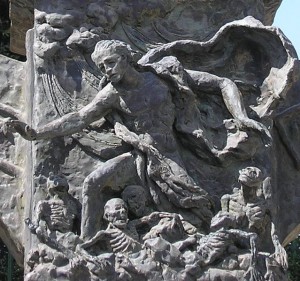Exile and Return in the Dead Sea Scrolls

Ezekiel’s vision of the dry bones, The Knesset Menorah, Jerusalem. Courtesy of Deror avi, Wikimedia Commons.
The theme of exile and return has been much discussed in the field of biblical studies. Roughly speaking, two basic approaches have been taken. One group sought to investigate the actual nature of the exile, better exiles–Assyrian and Babylonian, that ancient Israel experienced. Such studies attempt to reconstruct the historical reality experienced by individuals and the nation as a whole when enemies ravaged the land of Israel, sent off some of its inhabitants to captivity, and when, eventually, some of these inhabitants actually returned. A completely different approach has sought to understand the impact of the exile(s) and hope for return on the history of Israelite religion. Indeed, this theme has played a central role in prophetic thought and it was so fundamental in the ongoing history of Judaism that it eventually led to the actual return of the Jewish people–now about half of them—to the land of Israel and the creation of a modern state. This second approach seeks not the reconstruction of actual event’s and developments but rather the tracing of a set of ideas–a conception of history–and the role of these ideas in fostering the national and religious identity of ancient Israel/the Jewish people.
The present study, dealing especially with the role of these conceptions in the Dead Sea Scrolls, falls into the second category. We will not be concerned with the extent to which discussions of exile and return in the scrolls are historically accurate, and we certainly will not use them to better establish the nature of the events that actually took place in the Iron Age. Rather, we seek to understand the role that these concepts played among those Second Temple Jews whose literature was left for us in the caves of Qumran.
Notice that we have hedged regarding the identity of those whose views we are going to be discussing today. Clearly, some of these views are expressed in texts that represent what we might describe as the core of the ideology of those who gathered the library at Qumran and who lived in the buildings found at the site. Others, however, reflect predecessor groups, such as those that created the Enochic literature and Jubilees. But our main goal will be to elucidate the views of the Qumran sectarians and the specific manner in which these views played a role in their unique sectarian ideology.
Perhaps one of the most interesting aspects of our study will be the observation that from the point of view of the Qumran sectarians, and indeed in some other Second Temple sources as well, the return that took place during the Persian period and the creation of a Jewish commonwealth at that time, and even the rebuilding of the Temple, were not considered to be the fulfillment of biblical prophecies of return. Indeed, we will see that our authors write as if the exile continues in their own time, despite the fact that they are living in the land of Israel.[1] This is because for them, as for so many Jews throughout history, exile and return are not a description of one’s geographic position on the globe, but rather refer to a state of Jewish disunity, abandonment of Torah, and national powerlessness. Such a state was possible even within the land. Indeed, one who reads present-day debates about the religious status of the creation of the State of Israel in modern Jewish religious literature will detect that this view remains dominant among a considerable segment of today’s religious Jewish population, albeit a segment whose own self-perception is often that of a sectarian group. This is because ultimately the concepts of exile and return became theological topoi, a pattern already observable in Second Temple texts, and certainly in the Dead Sea Scrolls.
[1] Cf. Knibb and J.G. Campbell, “Essene-Qumran Origins in the Exile: A Scriptural Basis,” JJS 46 (1995) 143-56, esp. 148.

Leave a Reply